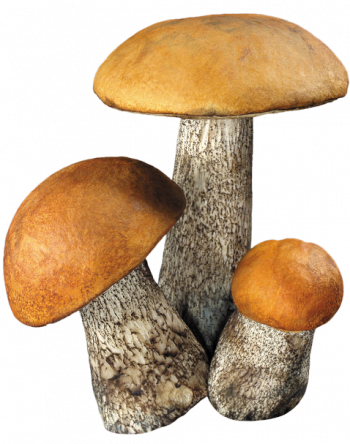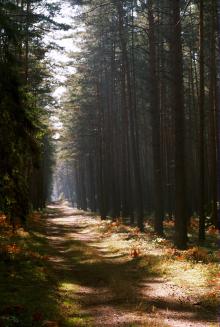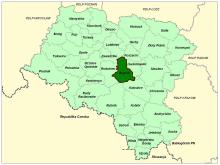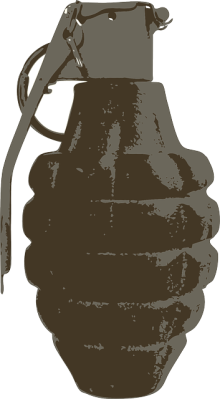Polish forests
Poland is in the European lead, while concerning the area of all forests. They cover about 29,2 % of the country territory, and grow within the area of 9,1 million hectares. The overwhelming majority of the forests is state owned, of which almost 7,6 million hectares are managed by the State Forests National Forest Holding..
The number of Polish forest is still growing. The forestation rate of the country has increased from 21 % in 1945 to 29,2 % at the moment. Between 1995 and 2008, the forest area increased by 310 thousand ha. The basis for afforestation works is the "National Programme for Increasing the Forest Cover" (KPZL), assuming an increase of the forestation rate up to 30 % by 2020 and up to 33 % by 2050. Polish forests abound in flora, fauna and fungi. 65 % of the total number of animal species live there.
The forests grow in our country on poor soils, mainly because of the development of the agriculture in previous years. It influences the distribution of the types of the forest sites in Poland. Over 55 % of the forest areas is covered with coniferous forests. In other areas, there are forest sites, mainly the mixed ones. Their small part constitute alder and riparian forests – not more than 3 %.
In the years 1945 – 2011 the area of natural deciduous tree stands within the area of the State Forests National Forest Holding increased from 13 to 28,2 %.
Within the lowlands and uplands the most often occurring tee species is pine. It covers 64,3 % of the forest area of the State Forests National Forest Holding and 57,7 % of private and commune forests. In the mountains the predominant species is European spruce ( in the west) and European spruce with beech (in the east). Domination of pine is the result of carrying on sustainable forest management in the past. Once, the monocultures (crops or cultivations of one species) were the answer to the great demand of industry for wood. Such forests appeared to be quite fragile to climatic factors. They also were often the prey of pests' expansion.
In Polish forests, the share of other tree species, especially deciduous trees have been systematically increasing. The foresters have stepped aside from monocultures – that is why, they try to fit specific species of the forest stand to the natural stand, that would be proper for the given area. Thanks to that, in the years 1945 – 2011, the area of the deciduous tree stands within the lands of the State Forests National Forest Holding increased from 13 to 28,2 %. There occur more and more frequently the following tree species: oaks, ashes, maples, sycamore maples, elms, but also birches, beeches, alders, poplars, hornbeams, aspens, tilias and willows.
Our forests are the most often represented by the forest stands aged 40 to 80 years. The average age of the forest equals 60 years. More and more trees are of big size at the age over 80 years. Since the end of the Second World War, the forests' area has increased up to almost 1,85 million hectares.
Raport o stanie lasów w Polsce 2012
 Asset Publisher
Asset Publisher
Grzybobranie – leśny savoir vivre
Grzybobranie – leśny savoir vivre
Sezon grzybowy w pełni, w związku z czym, chcielibyśmy przybliżyć Państwu kilka zagadnień związanych ze zbiorem aromatycznych przysmaków.
Po garść przydatnych informacji ogólnych odsyłamy Państwa na główną stronę Lasów Państwowych, gdzie można się dowiedzieć, jak zbierać i przechowywać grzyby (wycinać czy wykręcać – odwieczny dylemat rozwiązany!) a także gdzie zgłosić się po pomoc w ich rozpoznawaniu. W tym ostatnim pomocny może okazać się także artykuł, który ukazał się tutaj
Z naszej strony, dodajemy kilka informacji dotyczących zachowania się w lesie.
Przede wszystkim pragniemy Państwa uczulić – na większość dróg leśnych nie wolno wjeżdżać samochodem, ani innym pojazdem silnikowym (podstawa prawna - art. 29.1 Ustawy o Lasach)! Praktycznie można to zrobić tylko wtedy, kiedy droga jest oznaczona odpowiednimi znakami dopuszczającymi ruch. Zapraszamy do lasu pieszo lub rowerem, a samochody proponujemy zostawić na wyznaczonych miejscach postoju pojazdów. Umili to zarówno pobyt Państwu, jak i innym użytkownikom lasu, nienarażonym na hałas, spaliny i utrudnienia w poruszaniu się. Pamiętajmy, że pozostawienie przejezdnych dróg ma kluczowe znaczenie w przypadku pożaru w lesie. Uchroni to także Państwa przed ewentualnym mandatem, gdyż można nieświadomie popełnić wykroczenie (art. 161 kodeksu wykroczeń).
Przypominamy także, że chociaż w naszych polskich lasach nie ma żadnych poważnych ograniczeń dotyczących zbioru grzybów, a także nie występują limity ilościowe, należy mieć na uwadze, że nie zbieramy grzybów chronionych. Informacje o nich znajdą Państwo w atlasach lub rozporządzeniu Ministra Środowiska z roku 2014 w sprawie ochrony gatunkowej grzybów . Niewiele osób zdaje sobie sprawę, że niedozwolone jest także niszczenie grzybów i grzybni. Nie kopmy tych, które okazały się niejadalne, lub robaczywe! Nie tylko niszczymy w ten sposób przyrodę, ale i narażamy się na konsekwencje: art. 163 kodeksu wykroczeń mówi: Kto w lesie rozgarnia ściółkę i niszczy grzyby lub grzybnię, podlega karze grzywny albo karze nagany.
Z kolei w art. 153 czytamy: Art. 153. § 1. Kto w nienależącym do niego lesie:
1) wydobywa żywicę lub sok brzozowy, obrywa szyszki, zdziera korę, nacina drzewo lub w inny sposób je uszkadza,
2) zbiera mech lub ściółkę,
3) zbiera gałęzie, korę, wióry, trawę, wrzos, szyszki lub zioła albo zdziera darń,
4) zbiera grzyby lub owoce leśne w miejscach, w których jest to zabronione, albo sposobem niedozwolonym, podlega karze grzywny do 250 złotych albo karze nagany
Tak więc, chociaż las jest dla wszystkich, powinniśmy się w nim zachowywać jak goście szanujący gospodarza. Nie raz pracowników naszego nadleśnictwa zaskoczył smutny widok zniszczonego runa, poprzewracane grzyby a do tego stosy śmieci pozostawione w lesie, w okresie największego wysypu grzybów. Co roku wywozimy z lasu przeszło 250 m3 odpadów! Apelujemy o zabieranie swoich śmieci ze sobą (ich pozostawienie może skutkować grzywną – art. 162. § 1 kodeksu wykroczeń). Jeśli nieobca jest Państwu troska i bezinteresowność w dbaniu o wspólne dobro, zachęcamy także do wzięcia udziału w akcji - wyzwaniu #Zabierz5zlasu
Pamiętajmy, że wszyscy jesteśmy odpowiedzialni za to, żeby nasz skarb – lasy zachować w jak najlepszym stanie.


 fot. Paweł Fabijański
fot. Paweł Fabijański
 fot. Paweł Fabijański
fot. Paweł Fabijański
 fot. Paweł Fabijański
fot. Paweł Fabijański




